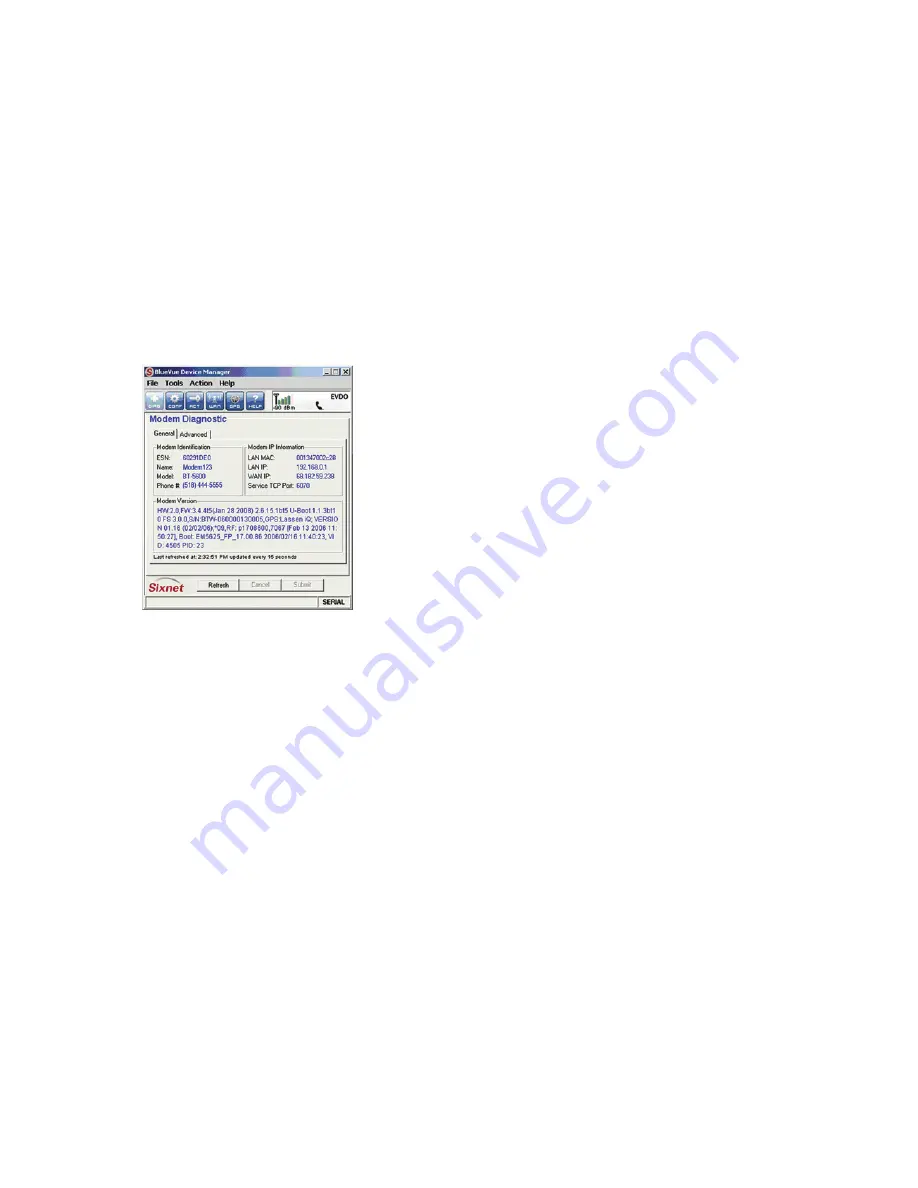
CONNECT. MONITOR. CONTROL.
© 2014 Red Lion Controls. All Rights Reserved
2
Quick Start Guide
3.
Wiring
and
power
‐
up
1.
Connect
the
modem
to
your
computer
using
a
standard
Ethernet
cable.
Alternatively,
the
RS
‐
232
or
USB
ports
can
be
used
for
setup.
2.
Connect
the
cellular
antenna
to
the
Antenna
connector.
3.
Plug
in
the
power
connector
to
power
‐
up
the
modem.
4.
Start
BlueVue
Device
Manager
Software
1.
Download
and
install
the
latest
version
of
BlueVue
Device
Man
‐
ager
from
www.redlion.net.
2.
When
launched,
it
will
attempt
to
connect
to
192.168.0.1
by
default,
once
connected
to
the
modem,
the
Modem
Diagnostic
window
will
open.
Note
that
192.168.0.1
connects
to
the
Ethernet
cable.
To
connect
to
the
USB
port
use
192.168.111.1):
Troubleshooting:
If
BlueVue
displays
“Detecting
Modem
at
192.168.0.1”
indefinitely,
then:
•
Make
sure
the
modem
is
powered
on.
•
Check
the
Ethernet
Link
LED
on
the
modem.
If
it’s
off,
it
usually
means
you
have
a
problem
with
the
Ethernet
cable
or
with
your
computer’s
network
card.
•
Close
all
other
network
connections
(such
as
WiFi)
•
Set
your
computer
to
obtain
an
IP
address
automatically
5.
Confirm
that
the
modem
is
acquiring
a
cellular
signal
The
Signal
LED
should
be
on
or
flashing,
indicating
that
the
modem
has
a
signal.
BlueVue
Device
Manager
displays
signal
information
in
the
top
right
of
its
window;
a
minimum
of
1
bar
is
required
to
connect
to
the
carrier
with
the
modem.
Troubleshooting:
If
the
Signal
LED
is
off,
then
there
may
be
an
issue
with
the
antenna
or
celluar
coverage
might
be
too
low
in
your
current
location.
6.
Set
the
WAN
data
connection
1.
In
BlueVue
Device
Manager,
click
on
the
WAN
button.
2.
Set
the
user
name
and
password
if
provided
by
the
carrier.
3.
Set
the
APN
as
provided
by
the
carrier.
4.
Click
submit.
5.
Confirm
the
modem
has
successfully
connected
to
the
cellu
‐
lar
network:
•
The
WAN
LED
will
be
on
or
flashing
•
In
BlueVue,
click
the
DIAG
button,
the
WAN
IP
shoudl
indicate
the
IP
address
assigned
to
the
modem
by
the
cellular
network.
SETUP
IS
COMPLETE
The
modem
should
be
ready
for
use
as
a
basic
internet
access
point.
For
more
advanced
modem
configuration,
consult
the
support
section
on
our
website:
www.redlion.net
INSTALLATION
AND
HAZARDOUS
AREA
WARNINGS
Suitable
for
use
in
Class
I,
Division
2,
Groups
A,
B,
C
and
D
hazardous
locations,
or
non
‐
hazardous
locations
only.
All
power,
input
and
output
(I/O)
wiring
must
be
in
accordance
with
Class
I,
Division
2
wiring
meth
‐
ods
and
in
accordance
with
the
authority
having
jurisdiction.
WARNING
‐
EXPLOSION
HAZARD
‐
DO
NOT
DISCONNECT
EQUIPMENT
UNLESS
POWER
HAS
BEEN
SWITCHED
OFF
OR
THE
AREA
IS
KNOWN
TO
BE
NON
‐
HAZARDOUS.
WARNING
‐
EXPLOSION
HAZARD
‐
SUBSTITUTION
OF
COMPONENTS
MAY
IMPAIR
SUITABILITY
FOR
CLASS
I,
DIVISION
2.
WARNING
‐
EXPLOSION
HAZARD
‐
BATTERIES
MUST
ONLY
BE
CHANGED
IN
AN
AREA
KNOWN
TO
BE
NON
‐
HAZARDOUS.
WARNING
‐
EXPOSURE
TO
SOME
CHEMICALS
MAY
DEGRADE
THE
SEAL
‐
ING
PROPERTIES
OF
MATERIALS
USED
IN
THE
RELAYS.
AVERTISSEMENTS
POUR
INSTALLATION
ET
ENDROITS
DANGEREUX
Cet
équipement
est
adapté
pour
une
utilisation
en
Classe
I,
Division
2,
Groupes
A,
B,
C
et
D
pour
endroits
dangereux
,
ou
endroits
non
‐
dan
‐
gereux
seulement.
Tout
câblage
électrique,
entrée
et
sortie
(I
/
O)
doi
‐
vent
être
en
conformité
avec
Classe
I,
Division
2
méthodes
de
câblage
et
conformément
à
l'autorité
compétente.
AVERTISSEMENT
‐
RISQUE
D'AVERTISSEMENT
‐
NE
DÉBRANCHEZ
PAS
L'ÉQUIPEMENT
PENDANT
QUE
LE
CIRCUIT
EST
DIRECT
OU
À
MOINS
QUE
L'ENVIRONNEMENT
SOIT
CONNU
POUR
ÊTRE
NON
‐
DANGEREUX.
AVERTISSEMENT
‐
RISQUE
D'EXPLOSION
‐
LA
SUBSTITUTION
DE
TOUT
COMPOSANT
PEUT
NUIRE
À
LA
CONFORMITÉ
DE
CLASSE
I,
DIVISION
2.
AVERTISSEMENT
‐
RISQUE
D'EXPLOSION
‐
LES
BATTERIES
DOIVENT
SEULEMENT
ÊTRE
REMPLACÉES
DANS
UNE
ZONE
RECONNUE
COMME
ÉTANT
NON
‐
DANGEREUSE.
AVERTISSEMENT
‐
L'EXPOSITION
À
CERTAINS
PRODUITS
CHIMIQUES
PEUT
DÉGRADER
LES
PROPRIÉTÉS
D'ÉTANCHÉITÉ
DES
MATÉRIAUX
UTIL
‐
ISÉS
DANS
LES
RELAIS
ÉTANCHE
PÉRIPHÉRIQUE.


